
current / archive / issues / faq / RSS feed / twitter /
To Bestride The World!
| < previous | next > |
 After so much Doom in recent issues of The Fantastic Four it's something of a surprise when he doesn't appear for the whole first "chapter" (apart from the silent splash page) of the series he officially co-stars in. Instead we spend a lot of time with an oil tanker, especially two crew members called Mickey and Turk who are so distinctly drawn and written that I think they must be references to real people.
After so much Doom in recent issues of The Fantastic Four it's something of a surprise when he doesn't appear for the whole first "chapter" (apart from the silent splash page) of the series he officially co-stars in. Instead we spend a lot of time with an oil tanker, especially two crew members called Mickey and Turk who are so distinctly drawn and written that I think they must be references to real people.
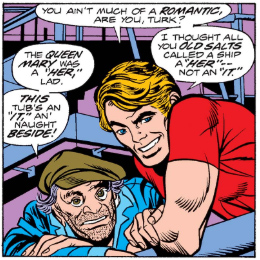 I guess they might be based on characters from a TV show but have no idea - any thoughts would be most welcome in the comments!
I guess they might be based on characters from a TV show but have no idea - any thoughts would be most welcome in the comments!
Namor shows up, tells them to leave Atlantean waters and then when they don't, sinks the ship. This does seem to be somewhat counter-productive - if he's bothered about surface dwellers impinging on his territory, surely he wouldn't want a dirty great tanker full of oil on the bottom of the sea - but he doesn't seem too bothered. Instead he heads back to Atlantis to mope around his people, who have been put in suspended animation, only being roused by the sounds of battle above.
This brings us to part two of the story, where he discovers an underwater army attacking the city. They're dressed in red and gold with a logo not unlike that of The Flash, but when Namor gets up close to one of them he discovers that it's -
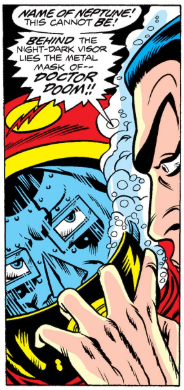 Except, of course, it isn't him - as usual Doom is not getting directly involved, he's simply projecting his face onto the inside of the helment, in a new twist on his old "floating TV screen" idea. He directs Namor to the surface, blowing up one of his own ships in the process to force him to get a move on, and when Namor arrives Doom greets him like an old pal.
Except, of course, it isn't him - as usual Doom is not getting directly involved, he's simply projecting his face onto the inside of the helment, in a new twist on his old "floating TV screen" idea. He directs Namor to the surface, blowing up one of his own ships in the process to force him to get a move on, and when Namor arrives Doom greets him like an old pal.
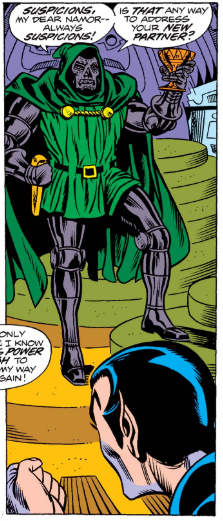 It turns out the attack was just a way to get Namor out in the open so Doom could re-propose an alliance. Personally, if I'm not answering my emails, I would prefer a phone call rather than a fleet of death robots attacking my flat, but super-villains probably have different priorities.
It turns out the attack was just a way to get Namor out in the open so Doom could re-propose an alliance. Personally, if I'm not answering my emails, I would prefer a phone call rather than a fleet of death robots attacking my flat, but super-villains probably have different priorities.
Doom tells Namor that he's reconsidered the matter and would like to have an alliance now, especially if Namor is going to be attacking the oil trade, as the more the world is in crisis the easier it is for Doom to seize control. There follows several pages of talking heads, dynamically illustrated nonetheless by Mike Sekowsky and Sam Grainger with cutaways and exciting expressions, where the pair discuss the nature of "super-villainy".
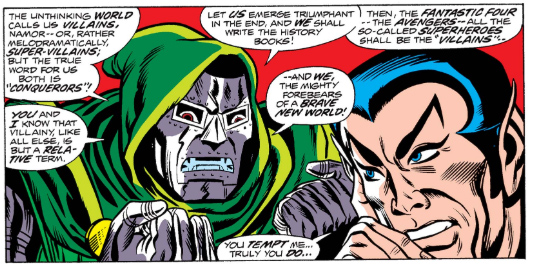 It's always weird in comics when the "villains" describe themselves as such, and Doom addresses this directly, saying that calling them "super-villains" is, to him, melodramatic and that, actually, seen from another angle it's them that are the heroes. As a brief SIDEBAR, I'd say that, according to screenwriting theory, characters like Doom and Namor really ARE the heroes. They're the ones who are always struggling against the system, striving to change themselves and the world, whereas the "superheroes" always act to maintain the status quo.
It's always weird in comics when the "villains" describe themselves as such, and Doom addresses this directly, saying that calling them "super-villains" is, to him, melodramatic and that, actually, seen from another angle it's them that are the heroes. As a brief SIDEBAR, I'd say that, according to screenwriting theory, characters like Doom and Namor really ARE the heroes. They're the ones who are always struggling against the system, striving to change themselves and the world, whereas the "superheroes" always act to maintain the status quo.
Anyway, their chat occurs as they fly back to Doom's castle in Latveria, where he unveils the latest version in a long line of android armies, which Doom is now using entirely instead of actual human lackeys because they are unable to betray him. Doom demonstrates this fact by ordering two nearby androids to fight to the death.
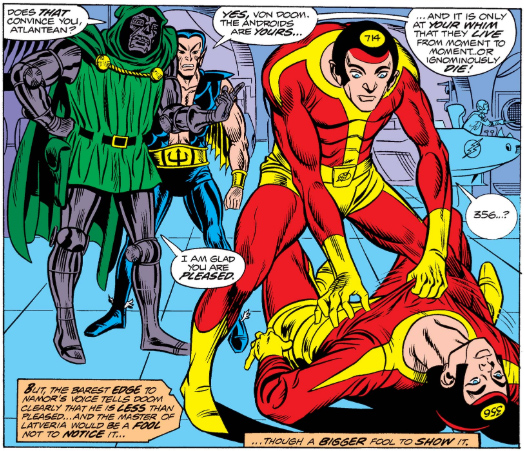 I love the simplicity of Android 714 whispering "356...?" here. It's a first gentle hint of problems ahead which Roy Thomas very skilfully builds up. The next hint follows soon after when they pass what appears to be a religious altar.
I love the simplicity of Android 714 whispering "356...?" here. It's a first gentle hint of problems ahead which Roy Thomas very skilfully builds up. The next hint follows soon after when they pass what appears to be a religious altar.
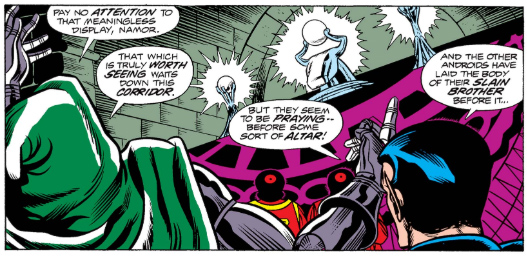 It never gets addressed in the story, but it's clear to anyone (who has read every single appearance of Doctor Doom so far) that the idols on the altar are meant to represent "The Faceless One" detaching his true form from his robot body way back in Astonishing Tales #3.
It never gets addressed in the story, but it's clear to anyone (who has read every single appearance of Doctor Doom so far) that the idols on the altar are meant to represent "The Faceless One" detaching his true form from his robot body way back in Astonishing Tales #3.
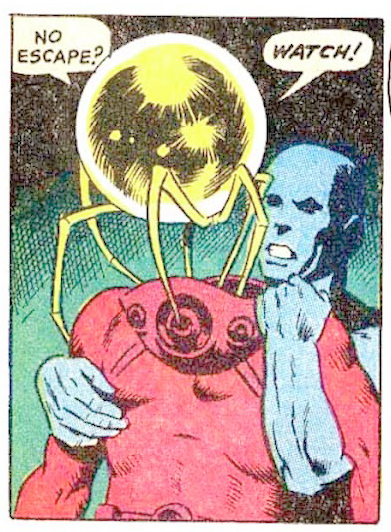 Hmm, didn't we talk about that particular issue recently?
Hmm, didn't we talk about that particular issue recently?
Doom dismisses this as a simple design flaw (which is odd, as surely his creations are perfect?) but Namor notices an odd look pass between two other androids. Again, this is lovely work from the whole creative team, slowly building up the sense that something isn't quite right and giving subtle hints as to what might be coming.
This is expanded on further over the next few pages as we see hundreds of androids worshipping at the altar, and the appearance of a Mysterious Figure who the androids bow down to. Doom and Namor are unaware, as they are viewing Doom's latest dastardly invention - solar panels!
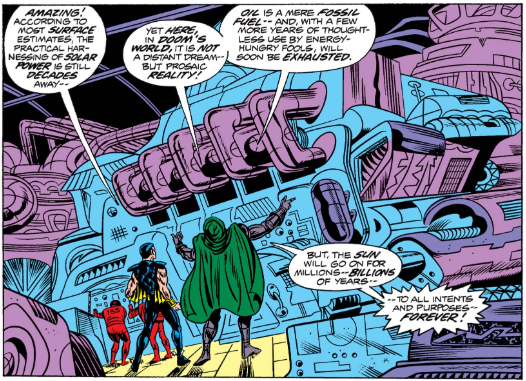 Doom, it turns out, is a green warrior, intent on replacing oil with solar power - what a madman!
Doom, it turns out, is a green warrior, intent on replacing oil with solar power - what a madman!
Doom brings his presentation to a close by showing how great their combined branding will be, drawing his own lighting flash logo (which has never previously been seen) over the top of Namor's trident.
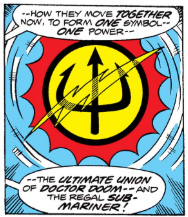 My advice: stick to Solar Energy, victor, brand design is not your strong point.
My advice: stick to Solar Energy, victor, brand design is not your strong point.
Before they can get onto a discussion about corporate fonts they are attacked by Doom's army of androids, now under the leadership of the Mysterious Figure, who is now calling himself "Andro, Lord Of The Androids".
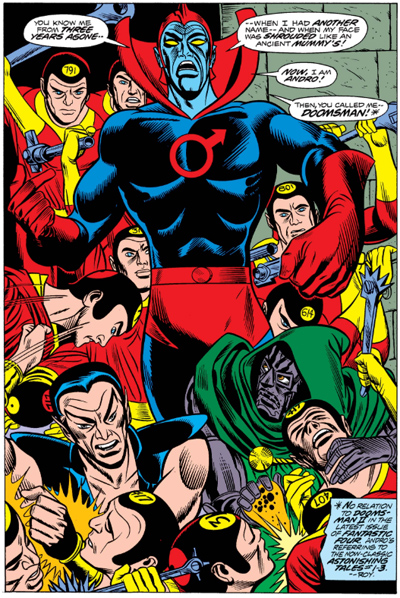 Andro is the original Doomsman - it's almost as if Roy Thomas went back and read Astonishing Tales as part of his recent data gathering exercise and came back with all sorts of ideas for new stories. Andro retells his origins, and explains how he escaped from the dimension where Doom exiled him. This involves yet more continuity, although this time it's to a story that hasn't even been published yet.
Andro is the original Doomsman - it's almost as if Roy Thomas went back and read Astonishing Tales as part of his recent data gathering exercise and came back with all sorts of ideas for new stories. Andro retells his origins, and explains how he escaped from the dimension where Doom exiled him. This involves yet more continuity, although this time it's to a story that hasn't even been published yet.
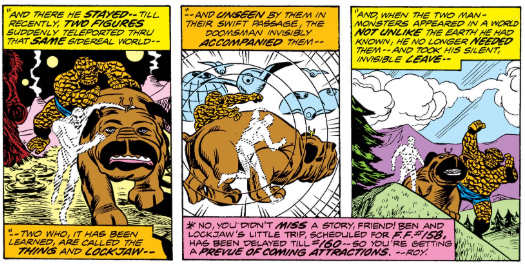 I've checked, and there's no mention of Doomsman in that issue, which seems an opportunity missed. A fight ensues, which Doom and Namor win by flooding the castle. These androids have been specifically designed to breath air (it's an anti-betrayal tactic, apparently), and Andro proves himself no better than Doom by sending his androids to drown. This is because, of course, Andro is designed to be a duplicate of Doom himself, with all of his ruthlessness. Andro points this out when the two of them come to blows, before immediately teleporting away.
I've checked, and there's no mention of Doomsman in that issue, which seems an opportunity missed. A fight ensues, which Doom and Namor win by flooding the castle. These androids have been specifically designed to breath air (it's an anti-betrayal tactic, apparently), and Andro proves himself no better than Doom by sending his androids to drown. This is because, of course, Andro is designed to be a duplicate of Doom himself, with all of his ruthlessness. Andro points this out when the two of them come to blows, before immediately teleporting away.
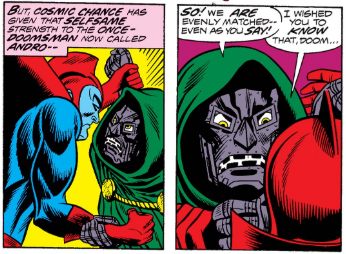 As with the previous story, a final battle is avoided through stalemate. This does seem to happen fairly often with Doom - I wonder if it's a way to avoid showing him actually winning? The triumph of evil was explicitly banned by The Comics Code Authority, and although they were much less powerful in 1975 than a decade or more earlier, especially after Amazing Spider-man #96 was issued without their approval (due to its mention of drugs), but perhaps Roy Thomas and other writers are still erring on the side of caution.
As with the previous story, a final battle is avoided through stalemate. This does seem to happen fairly often with Doom - I wonder if it's a way to avoid showing him actually winning? The triumph of evil was explicitly banned by The Comics Code Authority, and although they were much less powerful in 1975 than a decade or more earlier, especially after Amazing Spider-man #96 was issued without their approval (due to its mention of drugs), but perhaps Roy Thomas and other writers are still erring on the side of caution.
The story ends with another science fiction twist. Doom decides to go back to his original army of obedient robots, who never caused him any trouble, and as he and Namor go off to plot their next moves, we see a glint in the eye of one of his robot soldiers, suggesting matters might not be quite as straightforward as they think.
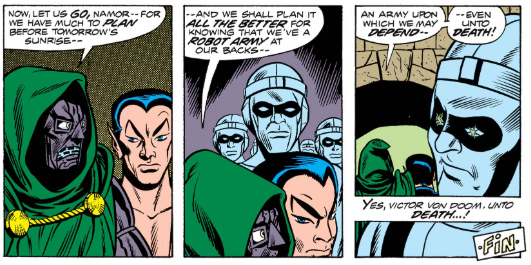 So ends the story and indeed the very short-lived "Giant-Sized" version of this series. Doom and Namor will return soon in a normal-sized version, but before then we have some distinctly different versions of Doom to enjoy, including what I think is the first alternate universe version of the character!
So ends the story and indeed the very short-lived "Giant-Sized" version of this series. Doom and Namor will return soon in a normal-sized version, but before then we have some distinctly different versions of Doom to enjoy, including what I think is the first alternate universe version of the character!
link to information about this issue
posted 17/5/2019 by Mark Hibbett
| < previous | next > |
Comments: